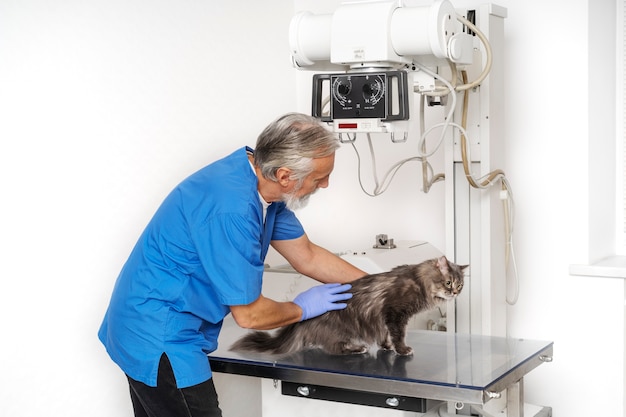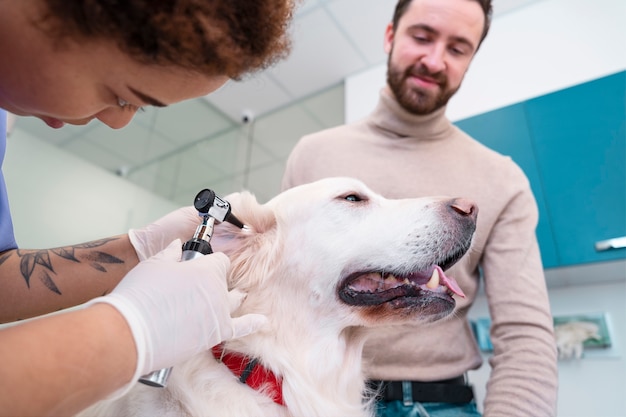Understanding Pet Ultrasounds: What to Expect


Understanding Pet Ultrasounds: What to Expect
If you have ever wondered what happens when your veterinarian recommends a pet ultrasound, you are not alone. Many pet owners in Johns Island and surrounding communities feel anxious or curious when their dog or cat needs an internal imaging procedure. At Angel Oak Animal Hospital, our team of veterinarians is committed to making every diagnostic experience as comfortable, clear, and beneficial as possible for both pets and their families.
Pet ultrasounds are a safe, noninvasive veterinary diagnostic procedure that allows us to look inside your pet’s body in real time, revealing vital information about their organs and overall health. Whether you are scheduling a routine wellness check or your pet is showing signs of illness, understanding what to expect during a pet ultrasound can ease your concerns and help you make informed decisions about your pet’s care. In this article, we will explain how pet ultrasounds work, what conditions they help diagnose, and how they fit into the broader approach to pet diagnostics in Johns Island. You will also find guidance on when to consider this advanced imaging procedure and how to schedule an appointment for veterinary diagnostic procedures with our caring team at 3160 Maybank Highway, Johns Island, SC 29455.
If you are searching for quality pet diagnostics near me or want to know how these services can benefit your furry family member, read on for a comprehensive look at pet ultrasounds and their role in keeping pets healthy.
When Might Your Pet Need a Veterinary Ultrasound?
Many pet owners wonder what situations call for a pet ultrasound and how to recognize when their companion might need this diagnostic tool. Veterinary ultrasounds are often recommended when a pet displays symptoms that cannot be fully explained by a physical examination or basic laboratory tests. Signs that your veterinarian may suggest an ultrasound include unexplained weight loss, persistent vomiting or diarrhea, visible abdominal swelling, changes in urination or defecation habits, and the discovery of lumps or masses during a routine exam.
Additionally, if your pet is experiencing ongoing discomfort, lethargy, or changes in appetite that do not improve with initial treatment, an ultrasound can provide crucial insights. In older pets, ultrasounds are sometimes used proactively during wellness exams to screen for internal organ health, especially in breeds prone to certain conditions. For families looking for pet diagnostics in Johns Island, recognizing these signs early and seeking timely veterinary advice can make a significant difference in your pet’s outcome.
How Do Pet Ultrasounds Work?
Pet ultrasounds use high-frequency sound waves to create real-time images of the organs and structures inside your pet’s body. Unlike x-rays, which offer a static image primarily of bones, ultrasounds excel at visualizing soft tissues such as the liver, spleen, kidneys, bladder, and heart. The procedure is noninvasive and generally painless, requiring only a small patch of shaved fur to allow the ultrasound probe to contact the skin.
When your pet arrives for a veterinary diagnostic procedure at Angel Oak Animal Hospital, our veterinary professionals will gently position your pet on a comfortable table. Most pets tolerate the procedure well without sedation, although a mild sedative may be used if your pet is especially anxious or restless. The veterinary team applies a special gel to the skin to ensure clear images, then glides the probe over the area of interest while watching the images on a monitor. This technology enables us to identify abnormalities such as tumors, cysts, organ enlargement, or fluid accumulation, all without the need for surgery.
For pet owners interested in learning more about the different imaging options available, our clinic also offers digital radiology for pets as part of a comprehensive approach to veterinary diagnostics in Johns Island.
Common Conditions Diagnosed by Pet Ultrasounds
Pet ultrasounds provide invaluable information in a variety of clinical situations. Some of the most common uses include evaluating unexplained abdominal pain, identifying bladder stones, detecting tumors or abnormal growths, and assessing organ function. Additionally, ultrasounds are frequently used to monitor pregnancies in dogs and cats, guide biopsies or fluid draws, and evaluate heart conditions.
For example, if a pet is experiencing frequent urination or blood in the urine, an ultrasound can reveal whether bladder stones or masses are present. In cases of persistent vomiting, an ultrasound helps determine if there are gastrointestinal blockages, foreign bodies, or changes in organ texture that require attention. When our veterinarians suspect heart disease, a cardiac ultrasound (echocardiogram) allows for a detailed assessment of heart structure and function.
By providing real-time visualization, pet ultrasounds in Johns Island help our veterinary team develop accurate diagnoses and tailor treatment plans to your pet’s specific needs.
What to Expect During Your Pet’s Ultrasound Appointment
Understanding what happens during your pet’s ultrasound can help you prepare for the visit and minimize any stress for both you and your pet. When you schedule an appointment for a veterinary diagnostic procedure at Angel Oak Animal Hospital, our team will provide detailed instructions tailored to your pet’s needs. In most cases, pets should fast for several hours before the procedure to ensure clear images, especially if the ultrasound is focused on the abdomen.
Upon arrival at our Johns Island location, your pet will be welcomed by our compassionate veterinary professionals, who will answer any questions you may have. The ultrasound itself typically takes between 20 and 45 minutes, depending on the area being examined and your pet’s comfort level. Most pets do not require anesthesia, and you are welcome to wait nearby during the procedure.
After the ultrasound, our veterinarians will review the images and discuss the findings with you. Sometimes, additional in-house diagnostic laboratory testing may be recommended to provide a complete picture of your pet’s health. Our priority is to ensure you understand the results and next steps, whether that involves starting a new treatment, performing additional tests, or simply continuing with preventive care.
The Role of Pet Ultrasounds in Preventive and Ongoing Care
Pet ultrasounds are not only used for diagnosing illnesses; they also play a valuable role in monitoring chronic conditions and supporting preventive health efforts. For pets with known heart disease, liver problems, or kidney issues, regular ultrasounds allow for ongoing assessment and early detection of changes. This proactive approach helps our veterinarians adjust treatment plans before problems become severe, improving your pet’s quality of life.
Preventive veterinary care is a cornerstone of our philosophy at Angel Oak Animal Hospital. By incorporating advanced pet diagnostic laboratory services in Johns Island into your pet’s wellness plan, we can identify issues earlier and provide targeted recommendations to keep your companion healthy. Whether your pet is young and active or a senior with special health considerations, pet ultrasounds are a valuable part of the comprehensive care we offer to families in Johns Island and surrounding communities.
Home Care and Steps to Support Your Pet’s Health
While pet ultrasounds are powerful diagnostic tools, there are steps you can take at home to support your pet’s health and reduce the need for emergency imaging. Maintaining a consistent feeding schedule, monitoring your pet’s weight, and ensuring regular exercise all contribute to overall wellness. Additionally, stay alert to any changes in your pet’s behavior, appetite, or bathroom habits, as these can be early indicators of internal issues.
Scheduling annual wellness exams and following your veterinarian’s recommendations for diagnostic testing are essential steps in preventive care. Early detection remains the best defense against many chronic conditions. If you have concerns or questions about your pet’s health, do not hesitate to reach out to our team for guidance and support.
When to Schedule a Veterinary Ultrasound
Knowing when to seek professional veterinary care is crucial for your pet’s wellbeing. If your dog or cat is experiencing persistent vomiting, diarrhea, weight loss, unexplained swelling, blood in the urine or stool, or sudden behavioral changes, it is important to schedule an appointment promptly. Other scenarios that warrant an ultrasound include the discovery of a lump or mass, difficulty breathing, or ongoing pain that does not resolve with rest.
As a trusted vet near me, Angel Oak Animal Hospital is here to provide compassionate, evidence-based care when your pet needs it most. Our team will work with you to determine if a pet ultrasound or other diagnostic procedure is appropriate, always prioritizing your pet’s comfort and your peace of mind.
Conclusion: Your Partner in Pet Diagnostics and Care
Pet ultrasounds are a cornerstone of modern veterinary diagnostic procedures, offering a safe and effective way to diagnose and manage a wide range of health concerns. At Angel Oak Animal Hospital, our veterinary professionals are dedicated to providing advanced pet diagnostics in Johns Island and surrounding communities, ensuring your pet receives the highest standard of care.
If you are searching for a quality vet near me or wondering whether a veterinary diagnostic procedure could benefit your pet, we encourage you to schedule an appointment with our experienced team. We are here to answer your questions, explain your options, and provide thorough, compassionate care every step of the way. To learn more about our full range of ultrasound diagnostic services for pets or to book a consultation, call (864) 806-2806 or visit us at 3160 Maybank Highway, Johns Island, SC 29455. Your pet’s health and happiness are our top priorities, and we look forward to being your partner in veterinary care.
Please note: This article is intended for informational purposes only and should not be used as a substitute for professional veterinary advice. If you have concerns about your pet’s health or are unsure whether a pet ultrasound is needed, always consult with your veterinarian for personalized recommendations.
For more information about our diagnostic laboratory services or to explore other advanced imaging options like digital radiology, visit our website or contact us directly. We are proud to serve pets and their families throughout Johns Island and surrounding communities with exceptional veterinary care.



















